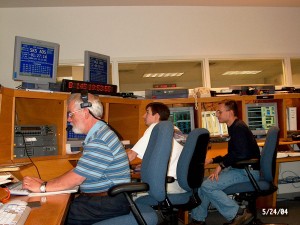Operations
UVIS was controlled by a microprocessor that operateed the instrument, executed various operating modes for data handling and compression, and buffered the instrument’s observation data for pickup by the Cassini Orbiter’s Command and Data Subsystem (CDS).
The Cassini spacecraft pointed the UVIS telescopes to the desired target (including stars, the Sun, atmospheric features, and the limbs of Saturn and its moons). The spacecraft attitude control allowed for slews, steps, or drifts across the target. Generally, these spacecraft motions were executed by commands issued from the spacecraft CDS. Synchronization of the instrument activities with the spacecraft motion was achieved by having the CDS send trigger commands to the UVIS at the correct time. These trigger commands instructed the UVIS to execute actions that have been pre-loaded in the UVIS memory.
The data from the observation were buffered for pickup by the CDS. Two pickup rates were allowed: 32 kbps (for occultations) and 5 kbps (for spectral imaging, FPSCAN, and all others). UVIS team members generated command sequences for each observation, which were loaded in the UVIS memory using a set of tools known as the Uplink Product Generation System (UPGS). The sequence of internal commands was then submitted to the sequencing team at JPL via the UVIS SOPC (Science Operations and Planning Computer). Using the SOPC and the UVIS GSE (Ground Support Equipment), the UVIS team could also monitor the health of the instrument in near real-time. In addition, the SOPC was used to access the data played back by the spacecraft and was stored in the JPL Telemetry Data Server (TDS). These data were processed and achieved at LASP.

